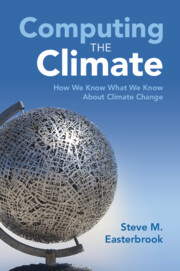Book contents
- Computing the Climate
- Epigraph
- Computing the Climate
- Copyright page
- Contents
- Preface
- Acknowledgements
- 1 Introduction
- 2 The World’s First Climate Model
- 3 The Forecast Factory
- 4 Taming Chaos
- 5 The Heart of the Machine
- 6 The Well-Equipped Physics Lab
- 7 Plug and Play
- 8 Sound Science
- 9 Choosing a Future
- References
- Index
3 - The Forecast Factory
Published online by Cambridge University Press: 10 August 2023
- Computing the Climate
- Epigraph
- Computing the Climate
- Copyright page
- Contents
- Preface
- Acknowledgements
- 1 Introduction
- 2 The World’s First Climate Model
- 3 The Forecast Factory
- 4 Taming Chaos
- 5 The Heart of the Machine
- 6 The Well-Equipped Physics Lab
- 7 Plug and Play
- 8 Sound Science
- 9 Choosing a Future
- References
- Index
Summary
Climate and weather are intimately connected. Weather describes what we experience day-to-day, while climate describes what we expect over the longer term. So it’s not surprising the models used to understand weather and climate share much of the same history. While Arrhenius’s model ignored weather altogether, focusing instead on the energy balance of the planet, modern climate models grew out of the early work on numerical weather forecasting – the basic equations for how winds and ocean currents move energy around, under the influence of the Earth’s rotation and gravity. The equations for these circulation patterns were first worked out by Arrhenius’s colleague, Vilhelm Bjerknes, in 1904, but it wasn’t until the invention of the electronic computer that John von Neumann put them to work forecasting the weather. The approach developed by von Neumann’s group now forms the core of today’s weather forecasting models.
- Type
- Chapter
- Information
- Computing the ClimateHow We Know What We Know About Climate Change, pp. 54 - 89Publisher: Cambridge University PressPrint publication year: 2023

